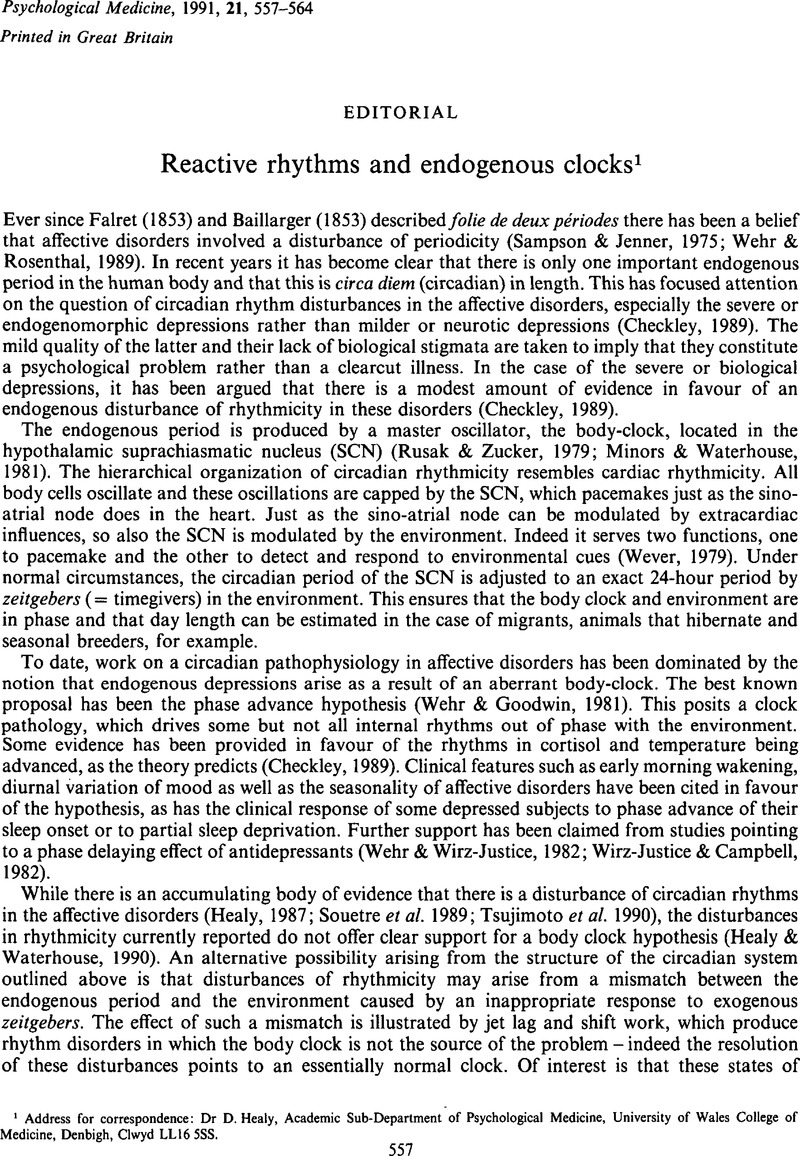Crossref Citations
This article has been cited by the following publications. This list is generated based on data provided by Crossref.
Healy, David
Minors, David S.
and
Waterhouse, James M.
1993.
Shiftwork, helplessness and depression.
Journal of Affective Disorders,
Vol. 29,
Issue. 1,
p.
17.
Van den Hoofdakker, R.H.
1994.
Chronobiological Theories of Nonseasonal Affective Disorders and Their Implications for Treatment.
Journal of Biological Rhythms,
Vol. 9,
Issue. 2,
p.
157.
Williams, C. J.
Yeomans, J. D. I.
and
Coughlan, A. K.
1994.
Sleep Deprivation as a Diagnostic Instrument.
British Journal of Psychiatry,
Vol. 164,
Issue. 4,
p.
554.
MINORS, D. S.
HEALY, D.
and
WATERHOUSE, J. M.
1994.
The attitudes and general health of student nurses before and immediately after their first eight weeks of nightwork.
Ergonomics,
Vol. 37,
Issue. 8,
p.
1355.
Healy, D.
and
Waterhouse, J.M.
1995.
The circadian system and the therapeutics of the affective disorders.
Pharmacology & Therapeutics,
Vol. 65,
Issue. 2,
p.
241.
Minors, David S.
Pirmohammed, Jacqueline
Williams, Gareth
Edwards, Richard
Healy, David
and
Waterhouse, James
1995.
Circadian Rhythms of Activity and Rectal Temperature at Home and in a Hospital: Effects of Lifestyle.
Chronobiology International,
Vol. 12,
Issue. 3,
p.
199.
Williams, G.
Pirmohamed, J.
Minors, D.
Waterhouse, J.
Buchan, I.
Arendt, J.
and
Edwards, R. H. T.
1996.
Dissociation of body‐temperature and melatonin secretion circadian rhythms in patients with chronic fatigue syndrome.
Clinical Physiology,
Vol. 16,
Issue. 4,
p.
327.
Duncan, Wallace C.
1996.
Circadian rhythms and the pharmacology of affective illness.
Pharmacology & Therapeutics,
Vol. 71,
Issue. 3,
p.
253.
Moneta, Giovanni B.
Leclerc, Annette
Chastang, Jean-François
Tran, Patrick Dang
and
Goldberg, Marcel
1996.
Time-trend of sleep disorder in relation to night work: A study of sequential 1-year prevalences within the GAZEL cohort.
Journal of Clinical Epidemiology,
Vol. 49,
Issue. 10,
p.
1133.
Adeniran, R.
Healy, D.
Sharp, H.
Williams, J. M. G.
Minors, D.
and
Waterhouse, J. M.
1996.
Interpersonal sensitivity predicts depressive symptom response to the circadian rhythm disruption of nightwork.
Psychological Medicine,
Vol. 26,
Issue. 6,
p.
1211.
Tornatzky, Walter
Cole, Jonathan C
and
Miczek, Klaus A
1998.
Recurrent Aggressive Episodes Entrain Ultradian Heart Rate and Core Temperature Rhythms.
Physiology & Behavior,
Vol. 63,
Issue. 5,
p.
845.
Scott, Allene J.
2000.
SHIFT WORK AND HEALTH.
Primary Care: Clinics in Office Practice,
Vol. 27,
Issue. 4,
p.
1057.
Knutsson, A.
and
Bøggild, H.
2000.
Shiftwork and Cardiovascular Disease: Review of Disease Mechanisms.
Reviews on Environmental Health,
Vol. 15,
Issue. 4,
Katz, G.
Durst, R.
Zislin, Y.
Barel, Y.
and
Knobler, H.Y.
2001.
Psychiatric aspects of jet lag: review and hypothesis.
Medical Hypotheses,
Vol. 56,
Issue. 1,
p.
20.
Scott MD, Allene J.
and
LaDou, Joseph
2001.
Patty's Toxicology.
Ohashi, Kyoko
Yamamoto, Yoshiharu
and
Natelson, Benjamin H
2002.
Activity rhythm degrades after strenuous exercise in chronic fatigue syndrome.
Physiology & Behavior,
Vol. 77,
Issue. 1,
p.
39.
Murray, Greg
Allen, Nicholas B
Trinder, John
and
Burgess, Helen
2002.
Is weakened circadian rhythmicity a characteristic of neuroticism?.
Journal of Affective Disorders,
Vol. 72,
Issue. 3,
p.
281.
Smits, M. G.
van Rooy, R.
and
Nagtegaal, J. E.
2002.
Influence of Melatonin on Quality of Life in Patients with Chronic Fatigue and Late Melatonin Onset.
Journal of Chronic Fatigue Syndrome,
Vol. 10,
Issue. 3-4,
p.
25.
Feldman, Ruth
2006.
From biological rhythms to social rhythms: Physiological precursors of mother-infant synchrony..
Developmental Psychology,
Vol. 42,
Issue. 1,
p.
175.
De Almondes, Katie Moraes
and
Araújo, John Fontenele
2011.
Sleep quality and daily lifestyle regularity in workers with different working hours.
Biological Rhythm Research,
Vol. 42,
Issue. 3,
p.
231.



